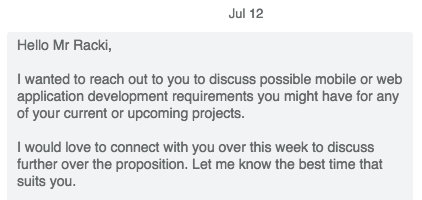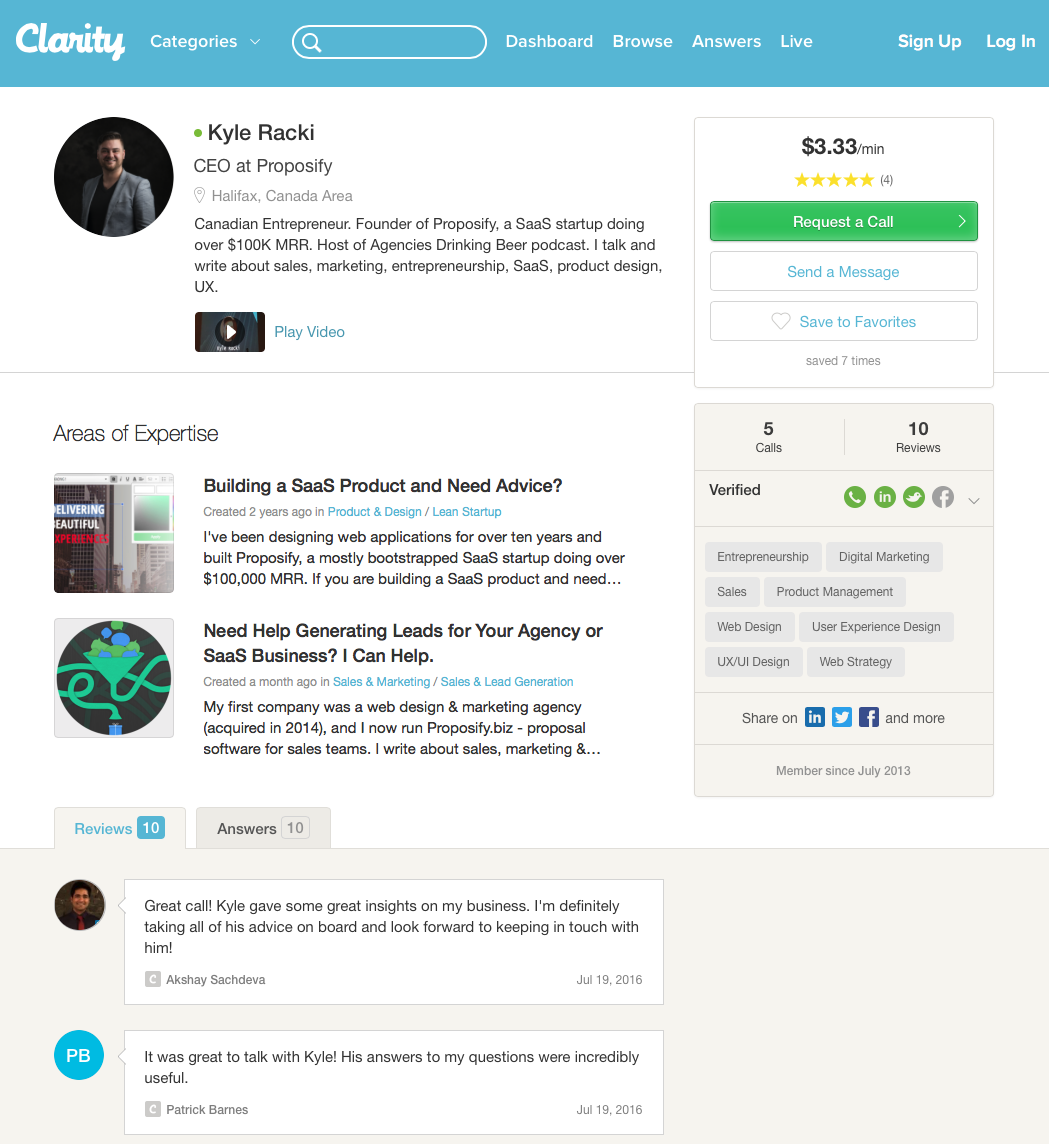Need Sales, Feedback or Advice? One Rule For Effective Cold Outreach
Published: July 22, 2016Updated: December 20, 2024

Connecting with people for sales, advice, feedback, and partnerships is paramount to running a successful business. Here’s how to reach out to strangers in a way that’s respectful and gets a response.
I was originally going to call this post “Stop asking to pick people’s brains”, or “How to make connections online without being a douche” but was advised against it.
In any case, we’ve all been there before, either on the receiving end of a new LinkedIn request asking to book a meeting, or maybe you’ve been the one doing the asking.
Social media allows us a chance to get in front of virtually everyone on the planet, if only for a fleeting moment. While technology for communication is evolving at an exponential rate, human beings are not. People still crave authentic connections.
As any recipient of a dick pic will inquire, why do so many still lack basic etiquette when reaching out to strangers online?

Consider this scenario, you’re sitting at the pub with a few friends when a stranger walks over with his eyes fixed on you.
Your immediate croc-brain response is “What does he want?”
Maybe he wants to ask what you ordered, or to compliment you on your new shorts? (Fact: I just bought new shorts)
Instead he says: “Hey, you look like a business person. Mind if I sit down with you and your friends to show you how I can help take your business to the next level?”

Now granted, most people would never do this in a pub, but they do it online every single day and then wonder why their response rate is so low.
Here’s just a sampling of the type of messages I get on a daily basis through LinkedIn (which I’m sure you get as well):

This is the equivalent of walking up to someone in a bar to make a sales pitch. It’s rude, it’s lazy, and gets ignored 100% of the time.
Why? Because it doesn’t offer me any value.
The one essential rule to effective cold outreach is value.
It’s a simple concept on paper, but creating real value in practice takes a lot of work.
How to offer value when cold-emailing prospects
Let me first say that I hate doing outbound, direct sales. Maybe it’s because I grew up knocking on doors. Maybe it’s because I’m a bit introverted. Whatever, I hate it.
But sometimes it needs to be done.
The steps to succeed in cold-emailing are (in this order):
- Do your homework on the person/company before sending an email
- Stand out by personalizing the message
- Make a super easy ask
Do your homework before sending an email
There’s no point wasting your time or your sales lead’s if they aren’t the right fit. Send fewer cold outreach emails but make them more targeted, and more focused on their specific pain point.
Personalize your message
People are obsessed with themselves.
Researchers from Harvard used brain scanning technology and found that when people talk about themselves it triggers the same chemical reaction they experience during sex and this motivates them to share personal information more regularly. [read more]

Use this to your advantage. Don’t talk about YOU, talk about THEM.
What have they done recently?
Have they been featured in any news articles?
What do they seem to be struggling with?
After talking a bit about them, give a quick elevator pitch; Here’s what I do, why I do it, and how it can help.
Make a super easy ask
Don’t ask for a call right away. It’s too much of an ask if there’s no prior relationship. You can add your phone number in the email signature, but leave it up to them to ask for a call.
You want to make it ultra easy for them to complete your ask, such as “download this free guide” or “watch this 30 second video”. No pressure.
Using a tool like Yesware, Sidekick, or Proposify, you can know when someone opens your email and whether or not they click the link, then follow up from there if there’s interest.
With any luck, it will be as good or better than the best cold email I ever received.
Optional: Invite a lead to be a guest on your webinar/podcast
Kevin and I interviewed James Carbary on our podcast about this. He actually uses his podcast as a lead generation tool by reaching out to CEO’s and other high-falutin’ people he sells to.
Instead of asking them for a phone call, he invites them to be a guest on his podcast.
This does a few things:
- Provides free value - You’re helping get their message in front of your audience, which is free exposure for them.
- Strokes their ego - It’s flattering to be asked to be on someone else’s show and because it’s all about them it makes them feel valued and important.
- Builds the relationship - Through the course of planning the show, talking before and afterwards, you get to know each other a bit, so they feel a warm connection.
Then afterwards you can make your pitch. You may not close every deal, but 100% of people will allow you to pitch them.
How to offer value when approaching prospects for feedback/validation

Asking potential customers for feedback on a new idea is absolutely essential for entrepreneurs. Customer development is how businesses are built.
But how do you solicit feedback from people you don’t know?
Much like with sales, your email should address the pain you’re solving instead of focusing on you or your solution. Your attempt to solve a customer’s pain could translate into potential value for them, which may intrigue them to help you out.
Here’s a sample email I’ve put together you could use as a template for reaching out to perform customer/market research.
Ideally, it would be best to send this to your list of warm contacts first, but if you don’t have that yet it could still work as a cold email, just remember to personalize it.
“Hi [name],
I’m emailing you because I’m working on a new project, a product that’s meant to help [your industry] better [solve particular problem]
The basic problem I’m trying to solve is this:
[outline the full problem that person probably faces every day]
The idea I have aims to help you [do x, y and z to solve this problem].
It’s just an idea and a simple mockup at this point, but I want to make sure:
a) I’m solving a real problem that needs fixing
b) I’m not missing any key insight that could make the solution more valuable
Will you chat with me so that I can better understand if this is a problem for you, and how you currently solve it?
If so, please book a 15 min call at your convenience: [your link to Calendly]
I promise, I'm not selling you anything (yet!)
PS: At the end of the call I’ll show you the UI mockup for what I’m planning. It’s pretty cool :)
Notice how I’ve focused more on them and how I can help them instead of talking about my solution?
How to offer value when approaching people for advice/mentorship
What if you don’t want to sell anything — what if you just need help from someone more experienced than you? Maybe you follow a blogger you admire or some other “influencer” and want to get their advice or get in front of their audience.
The higher up the food chain you go, the more busy and thus unavailable people will be. That’s just a fact of life. It doesn’t mean Seth Godin isn’t a nice person, it just means he gets a lot of requests for help and likely has to say no most of the time in order to keep his sanity.
The quick route is to just pay for their consulting time. If you don’t have the cash to spend, or if he/she doesn’t accept consulting offers, then consider the following story:
How 2+ years of patience paid off
One of our board members is Ben Yoskovitz.

Ben’s pretty well known in the startup world, having founded and invested in multiple companies. He blogs, speaks at conferences, and is the co-author of Lean Analytics (published by O'Reilly), a book that was very helpful for me in growing Proposify.
I haven’t always known Ben.
The first time I heard of him, I was at a startup conference and Ben was giving a talk on Lean Analytics. I liked what he had to say, and learned a lot from his talk so I said hi to him afterwards to thank him and ask a few questions. I gave him a brief elevator pitch on what we did.
Ben’s a nice guy, but I could tell this was just another quick conversation of many he already had in a dimly-lit hotel lobby that day, and it probably wouldn’t stick in his memory.
In any case, after the conference I bought his book.
And read the book.
And emailed him to tell him how much I loved the book.
And I tweeted about how awesome the book was.
And then I suggested (or he suggested, I can’t remember) that I write a guest post on his site about how the book helped me. (Here’s the post in case you’re interested)
Over the course of the next two years I occasionally kept in touch with Ben, letting him know how we were doing, showing him our metrics, asking for small bits of advice here and there, and commenting on and sharing his blog posts.
At some point, we had grown quite a bit and needed a third-party board member, one who was neither an investor nor a co-founder. We wanted someone who would bring a lot of experience to the table.
So I sent Ben an email and just outright asked him if he’d like to chat about being on the board.
After a few phone calls he accepted our offer. Would that have happened if I cold emailed him, or asked him the first time we met? Probably not.
Takeaway: Nurture relationships over time, because when you do eventually need to make an ask you’ll have already laid the groundwork. Good things come to those who wait.
Bonus tip: How to earn money when people ask you for calls
Whether or not you consider them an “influencer”, every working professional is busy.
While I am flattered when people ask me for help with their business, being asked for a phone call by a stranger without being offered anything in return comes across as arrogant.
It’s not like I consider myself above anyone else or too important to talk to someone.

I’m a regular guy with a diploma in graphic design from community college. I’m divorced with two kids. The highlight of my weekend was buying discounted shorts from a Banana Republic outlet. (Yes, the same shorts that were complimented in my hypothetical story.)
But time is precious and a finite resource for anyone, and if you or I say yes to everybody who demands our time we may not have time to focus on the more important things; Our families, our friends, our business, our health, and our hobbies.
Not to mention that for some people, consulting is their actual job. You wouldn’t ask a massage therapist for “just a quick massage”, you’d book an appointment and pay for it.
I came across the article No, You Cannot Have “A Few Minutes” Of My Time recently where Hanna Brooks Olsen denounces those who ask for free advice online and how she handles it (basically by saying “Sure, I charge $150/hour”, and seeing what happens).
I think I have a better way though.
Clarity is an online marketplace for people who want business advice from experts.
When a stranger reaches out for advice I respond with:
“Hey Finnegan, thanks for reaching out. I’d be happy to chat with you to help you out, feel free to book a call here: https://clarity.fm/kyleracki”
The link goes to my Clarity profile, and Clarity makes it clear that booking a call costs money. They either book the call or they don’t.

At the end of the call, Clarity automatically charges the caller for the time, takes their cut and puts the rest in my PayPal account.
When I see that the person really does value my time, I don’t mind digging in ahead of the call to learn more about their business and try to offer them as much value in as little time as possible while we’re on the phone.
Often I’ll give them my direct contact info for future follow-up because they’ve proven they don’t just want something for nothing. They’ve put their money where their mouth is.
If you’re finding yourself getting a lot of phone call requests, give this approach a try and let me know how it works for you.
But the bottom line is, everyone’s time is worth something. Show that you respect it by offering them something of value in return. If you do, you’ll drastically improve your success rate.

Co-founder and CEO of Proposify, and co-host of the Levership podcast. Outside of Proposify, he plays in the band Club Sunday, who put out their first LP in 2023 and enjoy playing live shows every chance they get. Follow him on LinkedIn.

